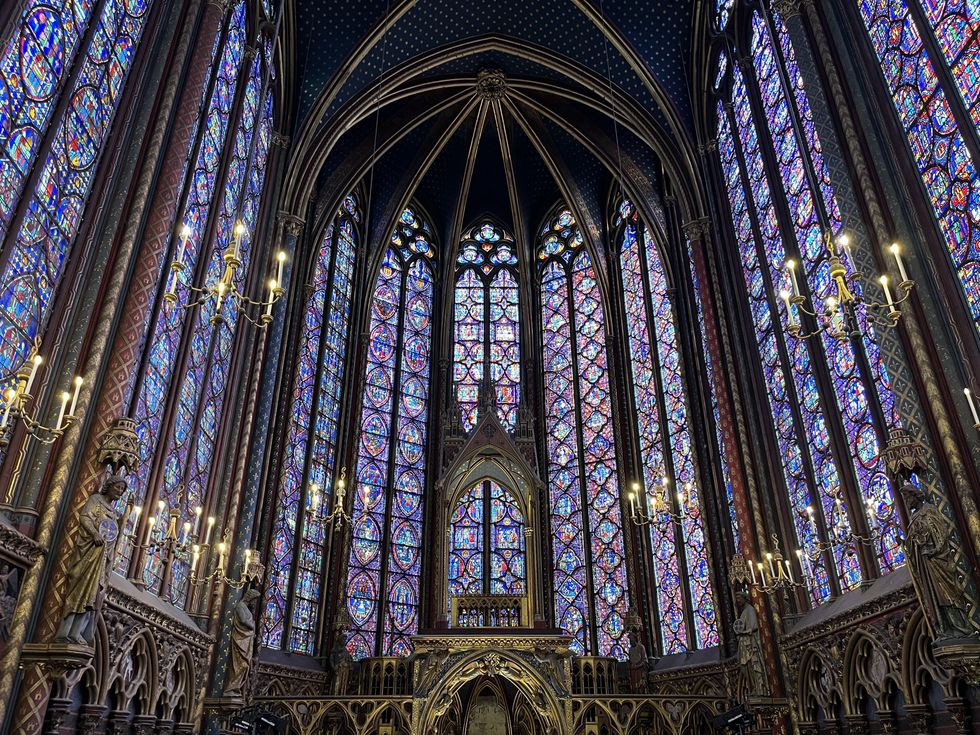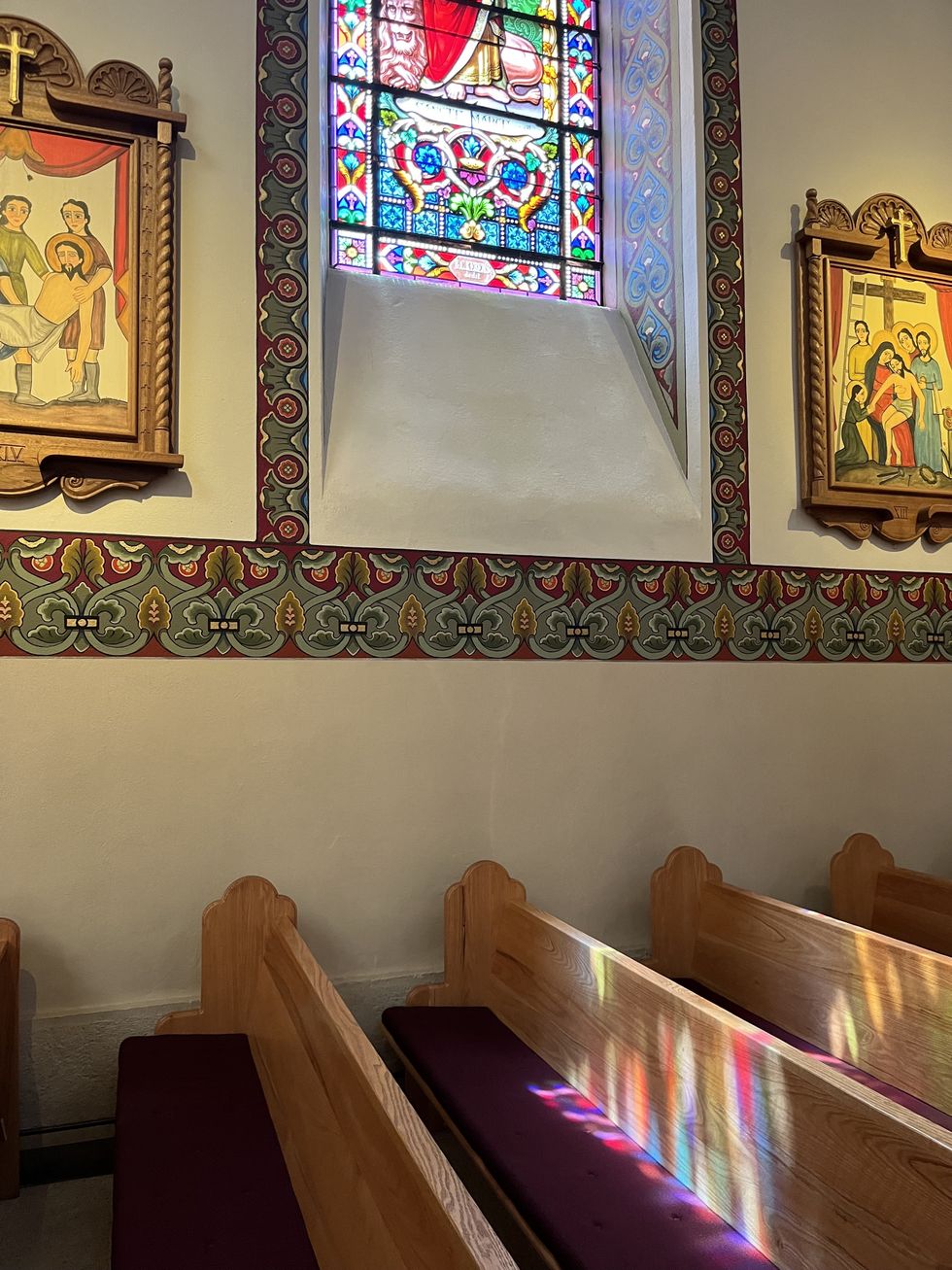
The same ritual persists anywhere I travel. Domestic or international, city or countryside, I find my way to church. Growing up in a strict denomination of christianity that tabooed musical instruments and forbid women from leading the congregation, I can’t say my return to these churches has much to do with nostalgia. Rather, for the feeling of refuge. As if—even for a few fleeting minutes—I am hermetically sealed off from the outside world. Stepping inside, everything transmutes. The temperature sinks, light dims, and sound softens as my senses sharpen. My heartbeat syncs with the slow rhythm of those who walked the same ground in centuries past. A church’s atmosphere is ineffable. And for me, nothing drives home this sense of wonderment better than the saintly glow of stained glass.
Stained glass is meditative. It’s mysterious and mesmerizing, intricate and reverential—perhaps that’s why it’s so fundamental to religious architecture, to evoke spiritual contemplation. Early traces of stained glass used in windows can be found dating back thousands of years, but its biggest admirer was the medieval church. One such house of worship that arrived at the apex of medieval civilization is Sainte-Chapelle within the Palais de la Cité (a stained glass pilgrimage I make every time I am in Paris). Louis IX commissioned it to house the Crown of Thorns, a most prestigious relic of the Passion of Christ. (It was later moved to Notre-Dame and subsequently rescued when fire broke out in 2019; the Crown of Thorns now resides in the Louvre museum.) Sainte-Chapelle’s astounding stained glass biblical scenes—there are 1,113 of them—are a purple-tinted visual feast of monumental scale.

Sainte Chapelle
In many ways, the process has gone unchanged since the early days—no doubt a testament to ingenuity of the time. A full-size drawing is made, including thick lines where the flexible, narrow strips of lead will define an outline. Colored glass is cut and shaped, then painted using varying techniques to create textural effects. The glass is heated in a kiln to harden the paint. Once this is completed, each piece of glass is meticulously positioned and a soldering iron joins the lead on either side to assemble the stained glass panel. It’s an art form for a lover of precision, collaboration, and patience. To love stained glass is to love color. To love depth in detail. To love refracted light and jewel-toned darkness. It’s like an X-ray into the soul.
While the technique remains similar, newer products reflect changing attitudes. Zip forward several hundred years to Barcelona circa the 19th century. Antoni Gaudí’s La Sagrada Familia is a storybook, candy-colored display of stained glass that exists in the parameters of a religious cathedral, but echoes contemporary ideals with its geometric shapes and Modernisme influences. The windows are utterly captivating; almost alien-like the way the hues wash over the stone surfaces like a holy invasion. Or there’s the Reims Cathedral in the Champagne region of France. I was dumbstruck by the deeply-pigmented panels housed inside this early 13th century church when I visited a few years ago. Turns out, they are by artist Marc Chagall who was commissioned to reimagine three of the church’s stained glass windows in the 1970s, which had been damaged by German grenades in the second World War. They are now, arguably, the most famous windows in the church.

La Segrada Familia

Reims Cathedral
Chagall didn’t find his way to stained glass until he was about 70 years old, but would go on to be considered a prolific stained glass artist, creating pieces like America Windows, a love letter to the city of Chicago in 1977 (the windows can be viewed in perpetuity at the Art Institute of Chicago). His affinity for municipal artwork came at a time when other artists were creating pieces for public enjoyment, such as Picasso’s Daley Plaza installation in 1967 or the “Sculpture in Environment” exhibition in New York that same year. For me, this signals a new era for stained glass—one that’s not so stickily synonymous with religion and can be enjoyed by anyone, devout or damned.
Some of the finest examples of modern stained glass tap back to this concept of public art. Just look at Louis Comfort Tiffany who created the iconic Tiffany lamp. Or Frank Lloyd Wright who invented Prairie Style stained glass, which forged a connection between interior and exterior worlds. Or even right now, artists who are translating stained glass to public spaces, creating a new context for its reverential beauty. Take Ara Starck, for example. Daughter of renowned Philippe Starck and an artist in her own right, the large-scale painter created a 57-foot-long stained glass piece for the entrance of L’Avenue at Saks Fifth Avenue. She also designed five windows along the staircase of La Réserve Eden au Lac, a luxury hotel on Lake Zurich that occupies a Bell Époque palace dating to 1909.

The Cathedral Basilica of Saint Francis of Assisi
In fact, hotels with stained glass have become a new sort of holy ground for me. Properties that occupy historic spaces and preserve their original stained glass are some of my most beloved places. In New York’s Catskill mountains, Hotel Lilien is a boutique hotel set inside a Victorian-era mansion. The photogenic mid-century modern interiors blend harmoniously with the building’s original stained glass panels. Then, there’s Columns in New Orleans. A garden district boutique hotel built as a private residence in 1883, it now offers guests the opportunity to relish its original architectural details, including a technicolor stained glass ceiling suspended above the original wood staircase. Or perhaps you prefer a European jaunt? Book a room at Hotel Cala di Volpe in Sardinia. French architect Jacques Couelle crafted the chunky stained glass panes here that look like gemstones plucked from the earth. Or perhaps you seek something Art Nouveau? Hotel Lutetia in Paris has preserved its original stained glass ceiling in the salon, making for quite the vibey glass of Champagne.
What I’ve come to appreciate most about stained glass is that it isn’t stagnant. It has evolved throughout its thousand-year history, much like it changes during the day as light refracts through the glass and eventually fades into dusk. It’s a passage back in time, but also a colorful promise that tomorrow will reveal something different and kaleidoscopic.
Want more stories like this?
Commemorating Two Decades of Mexico City's Art Week's Soaring Popularity
What About Winter?
This Hidden Baja Hotel Is Back




